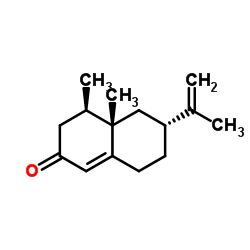Nootkatone

Nootkatone structure
|
Common Name | Nootkatone | ||
|---|---|---|---|---|
| CAS Number | 4674-50-4 | Molecular Weight | 218.335 | |
| Density | 1.0±0.1 g/cm3 | Boiling Point | 318.6±42.0 °C at 760 mmHg | |
| Molecular Formula | C15H22O | Melting Point | 35-39ºC | |
| MSDS | Chinese USA | Flash Point | 142.1±18.7 °C | |
| Symbol |

GHS07 |
Signal Word | Warning | |
|
CYP264B1 from Sorangium cellulosum So ce56: a fascinating norisoprenoid and sesquiterpene hydroxylase.
Appl. Microbiol. Biotechnol. 95(1) , 123-33, (2012) Many terpenes and terpenoid compounds are known as bioactive substances with desirable fragrance and medicinal activities. Modification of such compounds to yield new derivatives with desired properties is particularly attractive. Cytochrome P450 monooxygenas... |
|
|
A-Z of nutritional supplements: dietary supplements, sports nutrition foods and ergogenic aids for health and performance--Part 27.
Br. J. Sports Med. 45(15) , 1246-8, (2011)
|
|
|
Anti-diarrheal constituents of Alpinia oxyphylla.
Fitoterapia 89 , 149-56, (2013) Isolation, screening and in vivo assays have been used for evaluating anti-diarrhea bioactive of Alpinia oxyphylla. Preliminary experimental results showed that 95% ethanol extract and 90% ethanol elution significantly extended the onset time of diarrhea and ... |
|
|
Catalytic oxidation of concentrated orange oil phase by synthetic metallic complexes biomimetic to MMO enzyme.
J. Sci. Food Agric. 90(9) , 1460-6, (2010) This paper reports the catalytic oxidation of the concentrated orange oil phase using the complexes [Fe(III)(BMPP)Cl(micro-O)Fe(III)Cl(3)], [Cu(II)(BTMEA)(2)Cl]Cl and [Co(II)(BMPP)]Cl(2) biomimetic to methane monooxygenase enzyme as catalysts and hydrogen per... |
|
|
Biologically important eremophilane sesquiterpenes from alaska cedar heartwood essential oil and their semi-synthetic derivatives.
Molecules 16(6) , 4775-85, (2011) The essential oil of Alaska cedar heartwood is known to contain compounds which contribute to the remarkable durability of this species. While previous research has identified several compounds, a complete description of this oil has not been undertaken. In t... |
|
|
Nootkatone--a biotechnological challenge.
Appl. Microbiol. Biotechnol. 83(1) , 35-41, (2009) Due to its pleasant grapefruit-like aroma and various further interesting molecular characteristics, (+)-nootkatone represents a highly sought-after specialty chemical. (+)-Nootkatone is accumulated in its producer plants in trace amounts only, and the demand... |
|
|
Suppression of host-seeking Ixodes scapularis and Amblyomma americanum (Acari: Ixodidae) nymphs after dual applications of plant-derived acaricides in New Jersey.
J. Econ. Entomol. 104(2) , 659-64, (2011) We evaluated the ability of dual applications of natural, plant-derived acaricides to suppress nymphal Ixodes scapularis Say and Amblyomma americanum (L.) (Acari: Ixodidae) in a Lyme disease endemic area of New Jersey. An aqueous formulation of 2% nootkatone ... |
|
|
Structural requirements for repellency: norsesquiterpenes and sesquiterpenoid derivatives of nootkatone against the Formosan subterranean termite (Isoptera: Rhinotermitidae).
Pest Manag. Sci. 66(8) , 875-8, (2010) Research has shown that the family of grapefruit flavors called nootkatones have significant repellant and toxic effects to Formosan subterranean termites (Coptotermes formosanus Shiraki).Nineteen synthetic nootkatone derivatives, along with three commerciall... |
|
|
Biotransformation of citrus aromatics nootkatone and valencene by microorganisms.
Chem. Pharm. Bull. 53(11) , 1423-9, (2005) Biotransformations of the sesquiterpene ketone nootkatone from the crude drug Alpiniae Fructus and grapefruit oil, and the sesquiterpene hydrocarbon valencene from Valencia orange oil were carried out with microorganisms such as Aspergillus niger, Botryosphae... |
|
|
Experimental use of two standard tick collection methods to evaluate the relative effectiveness of several plant-derived and synthetic repellents against Ixodes scapularis and Amblyomma americanum (Acari: Ixodidae).
J. Econ. Entomol. 104(6) , 2062-7, (2011) We used two standard tick collection methods to test the relative effectiveness of two natural product compounds (nootkatone and carvacrol, classified as an eremophilene sesquiterpene and a monoterpene, respectively, that are derived from botanical sources) w... |